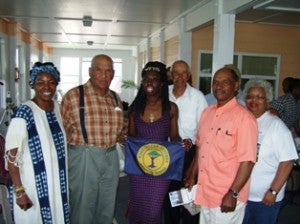During the past few months the Gullah/Geechee Sea Island Coalition and EDF have held listening sessions with African-American fishermen in the South Atlantic – from South Carolina to Florida and Georgia. The sessions provided us with the opportunity to listen and document the concerns of these fishermen working in commercial and subsistence fisheries.
Our series of listening sessions concluded last weekend in Sea Breeze, North Carolina. Fitting of its name, Sea Breeze once hailed as a popular beach destination for African-Americans in the Wilmington area. Members of the community recollected that on any given Friday night, Sea Breeze was alive with the sound of music and smell of cooked seafood. Our gathering was certainly reminiscent of the past, as local fishermen gathered around a feast of fresh seafood to discuss the important role fishing has played in their lives and how that has changed over time.
Queen Quet, Chieftess of the Gullah/Geechee nation and founder of the Gullah/Geechee Sea Island Coalition, led the meeting of nearly 30 participants. Although many do not continue to fish today, everyone in the room indicated they used to fish at one point in their lives. “Fishing was natural because the whole family did it,” explained attendee Mrs. McQuillan.
Only four men in attendance still remain in the commercial fishing sector with the years of experience varied among them. Fishing partners Luther McQuillan and Joe Farrow have been fishing for 60 and 70 years – a way of life that began when they were mere children. According to the four fishermen, Southeastern staples like shrimp, oysters, clams, and crabs were some of the more sought-after fish, in addition to croaker, mullet, red drum, and whiting.











![Loggerhead close up over aqua_2792097[1]_shutterstock_RF Loggerhead close up over aqua_2792097[1]_shutterstock_RF](https://blogs.edf.org/edfish/wp-content/blogs.dir/18/files/2010/01/Loggerhead-close-up-over-aqua_27920971_shutterstock_RF-300x186.jpg) The
The  At a recent meeting in Destin, FL, where members of our Gulf and South Atlantic teams met to discuss collaborative projects, I had the opportunity to see a commercial boat offloading its catch after a three day fishing trip. What an experience!
At a recent meeting in Destin, FL, where members of our Gulf and South Atlantic teams met to discuss collaborative projects, I had the opportunity to see a commercial boat offloading its catch after a three day fishing trip. What an experience!